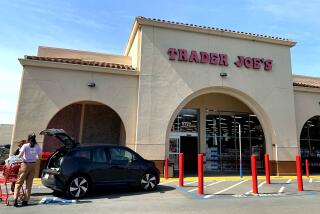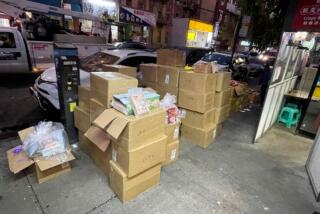China’s additives on menu in U.S.
SHANGHAI — As the recall of tainted pet food mushroomed into an international scandal, two of the largest U.S. food manufacturers put out a blanket order to their American suppliers: No more ingredients from China.
The directive from Mission Foods Corp. and Tyson Foods Inc., made quietly this month, underscored consumers’ and manufacturers’ fears about the safety of imported food ingredients after contaminated wheat products from China killed and sickened cats and dogs in the United States. The problem is, what Mission and Tyson want is next to impossible.In the last decade, China has become the world’s leading supplier of many food flavorings, vitamins and preservatives. Like fingernail clippers, playing cards, Christmas ornaments and other items, some food additives are available in vast quantities only from China.
China exported $2.5 billion of food ingredients to the United States and the rest of the world in 2006, an increase of 150% from just two years earlier, according to Chinese industry estimates. It is now the predominant maker of vanilla flavoring, citric acid and varieties of vitamin B such as thiamine, riboflavin and folic acid — nutrients commonly added to processed flour goods such as Mission tortillas and Tyson breaded chicken.
“It would be somewhat difficult to move away from all the vitamins in China,” said Monte White, president of Research Products Co., a large supplier of nutrients for flour mixes. He said his Salina, Kan.-based company was stepping up its testing of imported goods despite having had “very consistent results” from China in the last five years.
*
Little oversight in China
China’s overall food safety record is poor. Use of chemical fertilizers and toxic pesticides is heavy. Fraud and corruption often thwart what lax controls exist. In recent years, U.S. officials have issued alerts about Chinese honey tainted with a harmful antibiotic; Chinese candy containing sulfites that can cause fatal allergic reactions; and infant formula missing vital nutrients, which in China left a dozen babies dead in 2004.A small group of large manufacturers dominate the production of food ingredients in China, but hundreds if not thousands of small, virtually anonymous businesses — such as the two linked to the pet-food scandal — operate in an industry lacking tough standards and enforcement.
“Some of them are driven by profits; you can see dollar signs in their eyes,” said Jan Willem Roben, head of Vision Ingredients, a Shanghai-based trader of food additives.
In the U.S., major food manufacturers often don’t know where all their ingredients originate. Mission, a Texas-based unit of Mexican food giant Gruma, would not comment about that or its directive, but said it was working with its suppliers to ensure the products were safe. Arkansas-based Tyson, one of the nation’s largest providers of beef and chicken, did not respond to interview requests.
Many packaged foods contain dozens of items from around the world, acquired through complex networks of traders and brokers, before they get processed at manufacturing plants where companies have more direct oversight.
“Until now, companies just didn’t care about commodity additives,” said Laszlo Somogyi, a retired senior consultant at SRI International, a nonprofit research institute in Menlo Park, Calif. “But that might be changing now. This was a warning,” he said, referring to the pet-food debacle.
Somogyi believes tainted food additives pose a relatively low risk to humans because such ingredients are used in tiny amounts in any given product. Still, it wasn’t until the pet-food poisoning that people learned that melamine, an industrial chemical banned in foods in the U.S., had been widely added to animal feed in China to artificially boost its protein level.
“The same thing could have happened in the human food chain,” Somogyi said.
Chinese-made ingredients are probably found in every aisle of American supermarkets. Consider that American favorite, the Hostess Twinkie. Of its 39 ingredients, at least half a dozen — such as vitamin B compounds, the preservative sorbic acid and red and yellow colorings — are most likely made in China, says Steve Ettlinger, author of the book, “Twinkie, Deconstructed.”
In an interview from New York, Ettlinger said he couldn’t be sure where Interstate Bakeries Corp., the maker of Twinkies, obtained those ingredients. The Kansas City, Mo., company wouldn’t help him with his research, he said, and food makers rarely list the origin of individual ingredients on packages. Nor do they necessarily want to know where it all comes from.
“The more you know, the pickier you get and the more it costs,” Ettlinger said.
David Leavitt, Interstate Bakeries’ vice president of snack marketing, said he wasn’t aware of any Twinkie ingredients made in China. But in a brief e-mail statement, he indicated that Interstate was polling some of its smaller vendors to determine whether they obtained any products from China.
“This process involves gathering and verifying information from hundreds of companies,” Leavitt said.
That process could eventually lead to a company such as Ningbo Wanglong Group, the world’s largest maker of sorbic acid — a preservative made from natural gas that helps keep mold off baked goods and other products. The 14-year-old private company, located about 120 miles south of Shanghai, produces 1,000 tons of the white crystals every month. About one-third of that is exported to the U.S., said Li Ming, the company’s office director.
Less than a decade ago, such food additives were made mainly in Europe and the United States. But China’s looser environmental regulations, cheaper energy costs and lower wages helped shift the industry to Asia. Ningbo Wanglong’s average salary is less than $200 a month. Giant food chemical makers such as BASF of Germany and Dutch-based DSM have teamed up with Chinese partners and cut back at plants in the West.
Ningbo Wanglong says it sells sorbic acid for about $1.30 a pound, including shipping charges to the U.S. The cost of the same product made in the United States: about $4.
For food companies, switching to non-Chinese vendors would almost certainly increase their costs, though the move could give them a marketing advantage over rivals.
Li welcomed visitors to tour his company’s 80-acre campus, where he said 400 employees, many of them wearing white gloves and gray uniforms, work in 20 high-tech facilities.
“We have an analysis room, a quality lab and other quality control departments,” he said, adding that 70 workers have advanced degrees.
But for every additive maker such as Ningbo Wanglong, scores of small operations compete in China, offering their cut-rate goods in food industry journals, at trade fairs and on the Internet. On the Chinese e-commerce site Alibaba.com, at least 43 businesses claimed to produce sorbic acid, a complicated compound that requires considerable investment and government certifications.
For many other ingredients, though, people don’t need much more than basic knowledge of chemistry and some simple equipment: a kettle, a scale and a dryer.
“The problem is that many small companies don’t register their products as food additives, thus avoiding supervision,” said He Jiguo, director of the food nutrition and safety department at China Agricultural University in Beijing. Instead, he said, these companies classify their goods as nonfood items. Many food additives also have industrial applications; citric acid, for example, is used to clean boilers and etch concrete floors.
He says Chinese government officials should boost enforcement and penalties. Currently, violators of food-safety rules are subject to fines of no more than a few thousand dollars and a temporary stop order.
But He doesn’t expect any swift changes. Of the 1,750 government-approved food additives, quality standards have been established for only about 250, according to a report last year by Major China, a food-industry consulting firm in Shanghai.
“There is no clear food-classification system, no distinct definition for the range that the food includes, no related regulation about residues that additives leave on foods,” the report said. “All these bring loopholes for additives manufacturing and usage, give illegal traders opportunities and affects customers’ trust toward food additive safety.”
*
U.S. inspection spotty
Adding to U.S. consumers’ concerns, inspection on the American end is spotty. The Food and Drug Administration has said it checks just 1% of all imported grocery items and food ingredients, excluding meat and poultry products. The agency didn’t respond to interview requests for this article.U.S. food ingredient suppliers can only hope that the pet-food scare blows over. Some managers say they are getting 50 calls a day from customers and consumers. They are struggling to reassure them that the goods from China are safe, promising more tests and tighter monitoring of vendors. But they also say that American food manufacturers will have little choice but to back away from demands to go without any Chinese additives.
“They’re going to have to compromise,” said a sales manager at a major food additive supplier who did not want to be identified by name. “At this point, it’s simply impossible.”
*
don.lee@latimes.com
Cao Jun in the Times’ Shanghai bureau contributed to this report.
*(INFOBOX BELOW)
From China to you
China has become the world’s leading supplier of food ingredients, including flavorings, vitamins and preservatives. A look at some of the most common food additives imported into the United States from China:
Citric acid
Gives foods a tart taste and enhances fruit flavors
Used in: Soda, fruit-flavored beverages, candy, flavored syrups
*
Sorbic acid
A preservative that inhibits the growth of mold and yeasts
Used in: Cheese and other dairy products, baked goods, wine
*
Vanillin
An ingredient, often made from wood pulp, in artificial vanilla
Used in: Chocolates, candies, cookies
*
Xylitol
A natural sweetener found in birch trees, strawberries, raspberries and plums
Used in: Sugar-free gum, candy
*
Folic acid
A B vitamin that helps prevent fetal spinal deformities
Used in: Pasta, bread, cereal, flour, corn meal, rice
--
Sources: WISER, Census Bureau. Graphics reporting by Scott Wilson.







